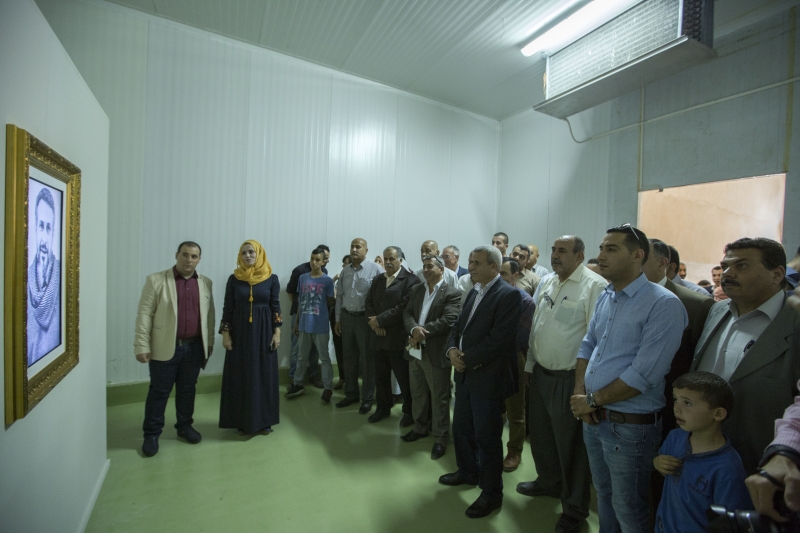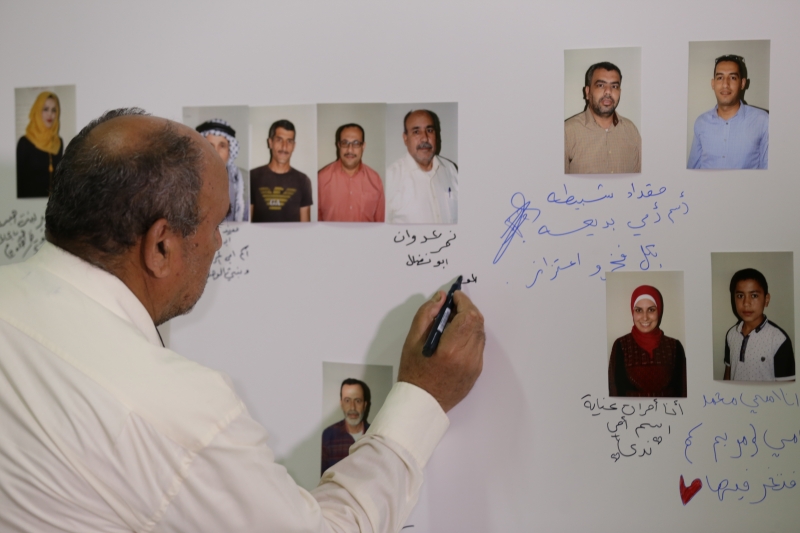
In the exhibition The Third Hand, the public built their own mural by hanging photos of themselves and writing their mothers’ names next to them. This work, titled Your Mother’s Name, is one of the four artworks featured in the exhibition, which was executed under the project “Culture, Art and Community Participation” through a long process of cooperation with artists, teachers, activists, researchers and students from Qalqilya.
The Third Hand, which ran for three consecutive days in Qalqilya, was recently concluded by The Educational Research and Development Programme (ERDP)/AMQF. It was visited by more than a thousand people.
The exhibition had been inaugurated by Rafe Rawajba, Governor of Qalqilya, Ziad Khalaf, AMQF Director-General, Wasim Kurdi, ERDP Director and Ragedah Andoni, Programme's Director at the Swiss Agency for Cooperation and Development (SDC) in Palestine.

The exhibition’s title, as explained by Malek Rimawi, ERDP Researcher and Director of the Languages and Social Sciences Stream, is inspired by the idea that a “Third Hand” retrieves the meanings of objects after they have been manufactured and sold by a first hand, then used and turned into junk by a second.
“The exhibition was intended for itself, as a way to place art at the center of an individual’s life,” said Rimawi. “It was also meant as an instrument of community work in order to create social dialogue and lay the foundation for diverse forms of community participation and accountability, based on citizen responsibility and the accountability of political representatives.”
The exhibition featured several works including a showcase where nine collage works were displayed. The works showed images of Qalqilya’s used furniture market, which is mostly spread across the city’s sidewalks, disrupting the movement of pedestrians. The idea behind the showcase was to crowd visual images as a simple representation of what passersby feel as they walk the city’s packed sidewalks.
Suhaib Mansour, one of the participating artists, chose to display images of used shoes in his work. He called it “Kisses to the Ground”. Next to the work, Mansour wrote, “They feel the ecstasy of reaching their destination, without feeling the road’s body, without laying a single kiss on the ground’s cheek. How can the steps possibly remember their past?”
Another participant, Abeer Odeh, put on display 16 framed panels embedded in one large panel carrying the title “Glances”. She explained, “Many eyes glanced [at the stories in the panels], but then went away, leaving them with thousands of hanging glances”.

Salam Abu Libdeh, a third participant, showcased her work “Bicycle Dreams”. The work, she explained, highlighted the life journey of bicycles, which starts when a child air-pumps a bicycle’s tires as he or she dreams of journeys and travels. As to Saeed Khader, who also participated at the exhibition, he chose his childhood years and family house to inspire his work. He used old kitchen tools as a reminder of the past.
Manar Zaid, another fellow participant, presented a work filled with clocks, which she titled “A Time for My Pulse”. “Time always escapes us, but it teaches us the art of intensity,” she commented.
The showcase also included other works created by participants Lamees Muein Turki, Mohammed Abu Abah, Maha Itmawi, Ismat Zaid and Leena Dawood.
The second work of the exhibition was quite different: the work, titled A Maqlooba of Sounds, revolved around the concept of an empty kitchen devoid of everything but sounds of cooking, pots, utensils, stoves and water taps resounding in each of its corners. These sounds represented the ones heard by women during the long hours they spend in the kitchen.
The third work featured at the exhibition, My Name is Mona Lisa, was a screen set in a golden frame showing short interviews of people introducing themselves by their mothers’ names. The work is a protest to the common practice of censoring women’s names in wedding invitations and electoral lists, among other things.
“It is lovely to see people willing to be part of a positive change,” said Yara Hilal, a young woman who visited the exhibition. Hilal was particularly impressed by the third work. She believed its concept to be an important social issue that needed to be addressed.
The exhibition’s fourth work revolved around the same theme tackled in My Name is Mona Lisa, but was based on an interactive approach with the public. The work featured a video showing faces of women accompanied by a woman’s voice saying “Justice for women”. The work invited exhibition visitors to have their photos taken and hanged on the white wall next to the video screen and to write their mothers’ names on them.
During preparations for the exhibition, a group of participants conducted several rounds around the city of Qalqilya asking residents to write their mothers’ names on empty cards, but many refused. Kamal Samara, an exhibition visitor who did write his mother’s name on the white wall, said that concealing women’s names is a commonplace practice in his social circles. He explained that this phenomenon was linked to concepts of “honor” and the fact that some men considered their female relatives’ names a private matter. Samara disagreed.
Commenting on this work, visual artist, Ra’afat Asaad, who took part in the production of the exhibition, said, “After the encounters we had organized with various community groups in Qalqilya, and having determined the issues that were most relevant to them, we first thought of building an illuminated mural in the city showing all cards with the mothers’ names. We eventually preferred to create a space that invited the public to build the artwork, rather than be its target.”
About his experience in The Third Hand, Asaad noted, “I have worked on community-related projects before, but have never worked in Qalqilya. It was a new and rich experience.” He added, “With the exhibition team, we worked to create a connection between art and the public. We explored how art expresses the public’s issues, then communicates with it in a clear fashion”.
The Third Hand was produced under the Culture, Art and Community Participation Project; a joint initiative between AMQF and SDC. Visual artists Ra’afat Asaad and Bashar Khalaf oversaw the production, alongside stage director Eid Aziz, film director Bilal Khateeb, Qattan researchers Malek Rimawi, Abdel Karim Hussein and Vivian Tannous, as well as Qattan’s Multimedia Unit photographer Youssef Karaja.
